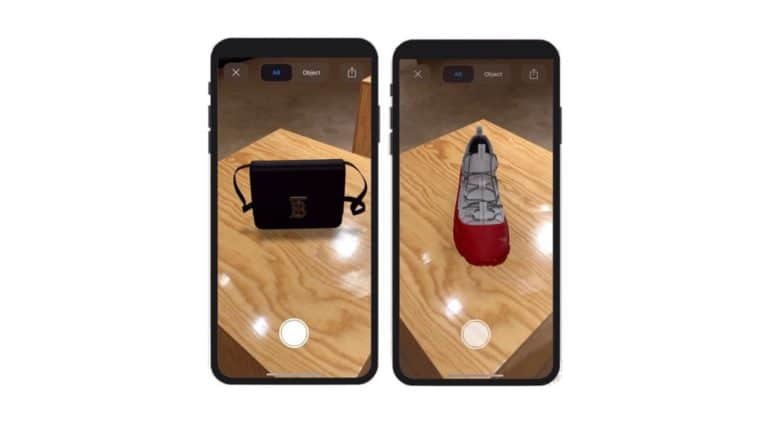
AR continues to prove itself as a shopping tool. It can help consumers visualize products on faces and spaces, to make better-informed decisions. This was amplified in the Covid era as it brought back some of the product essence and dimension that was lost in retail lockdowns.
Beyond consumers, AR likewise resonates among brands, retailers, and eCommerce companies. On one level, it appeals to their creative sensibilities — erstwhile stuck in 2D media — to demonstrate products in their full 3D glory. On a more practical level, they’re seeing real results.
Among retailers and eTailers, few standouts that have leaned into AR product visualization include IKEA, Wayfair, Houzz, and Shopify. They’ve each launched features or apps to help consumers visualize products. It’s all about boosting buyer confidence with a better sense of fit and style.
But despite all of these benefits, AR adoption is still held back by a few common myths. So in the spirit of myth-busting, a heavy-hitter panel at the recent Brand Innovators show weighed in, which we’re featuring for part II of our XR Talks series on camera commerce’s transformation.

Staying Power
Jumping right into the myth-busting, XR maven and panel moderator Tony Parisi teed them up as follows: 1. AR is a fad; 2. It’s hard and expensive to produce; 3. It only works in certain verticals; And 4. there’s no ROI (or clarity in ROI). Let’s take these one at a time.
Starting with AR’s fad label, this myth can be dispelled by consumer sentiments. Specifically, LoopMe’s Christina Park cites her company’s survey data that show that almost 20 percent of consumers are more likely to pay attention to interactive ads, and 40% find AR try-ons useful.
IAB’s Zoe Soon points to Google, Apple and Facebook’s massive AR investments, which have accelerated the cultural learning curve. That curve for emerging tech often goes from understanding to expectation. We’re still in the first step but quickly approaching the second.
And as often happens, brand adoption is a lagging indicator. In this case, they’re following the consumer sentiments above, says Digitas’ Keith Soljacich. In fact, Soon reports that 97 percent of Forbes’ most valuable brands are starting to apply some degree of AR marketing.
Range of Applicability
On to the second myth — AR is expensive and hard to produce — Soljacich asserts that there are “levels,” just like anything else. This includes low-hanging fruit AR activations that can ease brands in, all the way up to Hollywood-style endeavors. It’s all about aligning campaign goals.
Parisi adds that brands can outlay as little as a four-digit sum for AR campaign production costs, plus a modest paid ad budget to amplify it. Game engines such as Unity have driven these prices down in terms of 3D creation and application. Either way, AR won’t break the bank.
Meanwhile, the third myth — AR is vertical-specific — can be quickly countered with the range of applicability we’re seeing in case studies from whiskey to wall art. There are a few verticals out of the gate first, such as film & entertainment, but AR marketing is broadly applicable.
CPG could be next as its a commodity that’s hungry for differentiation, says Park. Parisi adds that it’s not just about AR/3D models of cereal boxes and toothpaste, but rather opportunity to enliven those packages with deeper demonstrations of products to boost conversions.
Participation Generation
And the final myth — there’s no ROI — can likewise meet quick counterpoints including the campaign ROI metrics we continue to see in AR case studies. For example, Soon cites IAB data that virtual tryons increase conversions 3x, and usage frequency has grown in the Covid era.
But it depends, again, on-brand and campaign goals. The hard numbers are there, per the above, but AR can also help achieve broader brand objectives like reaching Millenials and Gen-Z. Soljacich asserts that AR’s interactivity is fertile ground for the “participation generation.”
Looking forward, what are the challenges in getting to all of the above endpoints? Park says it’s all about reducing friction and raising consumer trust/comfort levels. Both will alleviate barriers currently seen in AR activation and onboarding, such as sharing camera access.
Soljacich meanwhile believes the challenge lies in educating brand marketers. And Soon, true to IAB form, sees challenges in standardizing AR metrics. These should be unique to AR, yet comparable to the clicks and impression- KPIs that marketers are comfortable with today.
Lastly, Parisi reminds us that there are many flavors of AR. It’s known mostly for placing virtual objects in your space, but the other half of the magic is using your camera to recognize the world (a.k.a. visual search). The latter could be a sleeping giant in unlocking camera commerce.
We’ll pause there and cue the video below for the full panel discussion…






